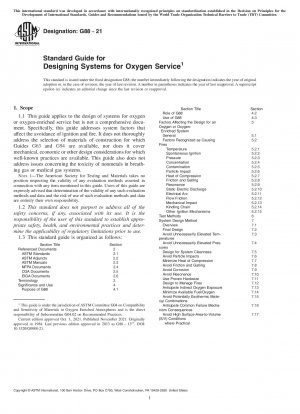ASTM G88-21
Standard Guide for Designing Systems for Oxygen Service
- Standard No.
- ASTM G88-21
- Release Date
- 2021
- Published By
- American Society for Testing and Materials (ASTM)
- Latest
- ASTM G88-21
- Scope
- 1.1 This guide applies to the design of systems for oxygen or oxygen-enriched service but is not a comprehensive document. Specifically, this guide addresses system factors that affect the avoidance of ignition and fire. It does not thoroughly address the selection of materials of construction for which Guides G63 and G94 are available, nor does it cover mechanical, economic or other design considerations for which well-known practices are available. This guide also does not address issues concerning the toxicity of nonmetals in breathing gas or medical gas systems. NOTE 1—The American Society for Testing and Materials takes no position respecting the validity of any evaluation methods asserted in connection with any item mentioned in this guide. Users of this guide are expressly advised that determination of the validity of any such evaluation methods and data and the risk of use of such evaluation methods and data are entirely their own responsibility. 1.2 This standard does not purport to address all of the safety concerns, if any, associated with its use. It is the responsibility of the user of this standard to establish appropriate safety, health, and environmental practices and determine the applicability of regulatory limitations prior to use. 1.3 This standard guide is organized as follows: Section Title Section Referenced Documents 2 ASTM Standards 2.1 ASTM Adjuncts 2.2 ASTM Manuals 2.3 NFPA Documents 2.4 CGA Documents 2.5 EIGA Documents 2.6 Terminology 3 Significance and Use 4 Purpose of G88 4.1 Section Title Section Role of G88 4.2 Use of G88 4.3 Factors Affecting the Design for an Oxygen or OxygenEnriched System 5 General 5.1 Factors Recognized as Causing Fires 5.2 Temperature 5.2.1 Spontaneous Ignition 5.2.2 Pressure 5.2.3 Concentration 5.2.4 Contamination 5.2.5 Particle Impact 5.2.6 Heat of Compression 5.2.7 Friction and Galling 5.2.8 Resonance 5.2.9 Static Electric Discharge 5.2.10 Electrical Arc 5.2.11 Flow Friction 5.2.12 Mechanical Impact 5.2.13 Kindling Chain 5.2.14 Other Ignition Mechanisms 5.2.15 Test Methods 6 System Design Method 7 Overview 7.1 Final Design 7.2 Avoid Unnecessarily Elevated Temperatures 7.3 Avoid Unnecessarily Elevated Pressures 7.4 Design for System Cleanness 7.5 Avoid Particle Impacts 7.6 Minimize Heat of Compression 7.7 Avoid Friction and Galling 7.8 Avoid Corrosion 7.9 Avoid Resonance 7.10 Use Proven Hardware 7.11 Design to Manage Fires 7.12 Anticipate Indirect Oxygen Exposure 7.13 Minimize Available Fuel/Oxygen 7.14 Avoid Potentially Exothermic Material Combinations 7.15 Anticipate Common Failure Mechanism Consequences 7.16 Avoid High Surface-Area-to-Volume (S/V) Conditions where Practical 7.17 1 This guide is under the jurisdiction of ASTM Committee G04 on Compatibility and Sensitivity of Materials in Oxygen Enriched Atmospheres and is the direct responsibility of Subcommittee G04.02 on Recommended Practices. Current edition approved Oct. 1, 2021. Published November 2021. Originally approved in 1984. Last previous edition approved in 2013 as G88 – 13ε1 . DOI: 10.1520/G0088-21. Copyright © ASTM International, 100 Barr Harbor Drive, PO Box C700, West Conshohocken, PA 19428-2959. United States This international standard was developed in accordance with internationally recognized principles on standardization established in the Decision on Principles for the Development of International Standards, Guides and Recommendations issued by the World Trade Organization Technical Barriers to Trade (TBT) Committee. 1 Section Title Section Avoid Unnecessarily-Elevated Oxygen Concentrations 7.18 Anticipate Permutations from Intended System Design 7.19 Avoid Designs and Failure Scenarios that can Introduce Potential Flow Friction Ignition Hazards 7.20 Use Only the Most Compatible of Practical Materials and Designs 7.21 Provide Thorough Safety Training for All Personnel Working with Oxygen or OxygenEnriched Components or Systems, including Design, Cleaning, Assembly, Operations, and Maintenance as Applicable to Personnel 7.22 Miscellaneous 7.23 Examples 8 Key Words 9 References 1.4 This international standard was developed in accordance with internationally recognized principles on standardization established in the Decision on Principles for the Development of International Standards, Guides and Recommendations issued by the World Trade Organization Technical Barriers to Trade (TBT) Committee.
ASTM G88-21 Referenced Document
- ASTM G128 Standard Guide for Control of Hazards and Risks in Oxygen Enriched Systems
- ASTM G175 Standard Test Method for Evaluating the Ignition Sensitivity and Fault Tolerance of Oxygen Pressure Regulators Used for Medical and Emergency Applications*, 2021-12-01 Update
- ASTM G63 Standard Guide for Evaluating Nonmetallic Materials for Oxygen Service
- ASTM G72 Standard Test Method for Autogenous Ignition Temperature of Liquids and Solids in a High-Pressure Oxygen-Enriched Environment
- ASTM G74 Standard Test Method for Ignition Sensitivity of Materials to Gaseous Fluid Impact
- ASTM G93 Standard Practice for Cleaning Methods and Cleanliness Levels for Material and Equipment Used in Oxygen-Enriched Environments
- ASTM G94 Standard Guide for Evaluating Metals for Oxygen Service
ASTM G88-21 history
- 2021 ASTM G88-21 Standard Guide for Designing Systems for Oxygen Service
- 2013 ASTM G88-13e1 Standard Guide for Designing Systems for Oxygen Service
- 2013 ASTM G88-13 Standard Guide for Designing Systems for Oxygen Service
- 2005 ASTM G88-05 Standard Guide for Designing Systems for Oxygen Service
- 1990 ASTM G88-90(1997)e1 Standard Guide for Designing Systems for Oxygen Service
